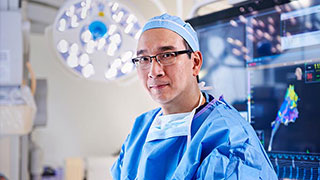Multidisciplinary, Experienced Care
At UT Southwestern, our multidisciplinary Sports Medicine team includes orthopaedic surgeons, physical therapists, athletic trainers, chiropractors, nutritionists, psychologists, and other health care providers. Our specialists work together to create a comprehensive treatment plan that is tailored to each patient’s unique needs.
We treat a high volume of patients with a wide range of sports-related injuries, and we have extensive experience with hip and thigh conditions. We cater to patients at every level, whether they’re professional athletes, varsity and collegiate athletes, or highly competitive amateurs. Our orthopaedic surgeons are trusted by athletes throughout North Texas.
Conditions Affecting the Hip and Thigh
Our orthopaedic specialists treat the following sports-related hip and thigh injuries and disorders:
- Hamstring muscle strain
- Hip bursitis (trochanteric bursitis)
- Hip labral tear
- Hip strains
- Hip stress fracture
- Muscle strains in the thigh
- Snapping hip syndrome (repetitive movement of the hip)
Symptoms
Thigh
Symptoms of a sports-related thigh injury or disorder, such as a hamstring strain or thigh sprain, include a sudden sharp pain in the thigh during fast movement. Depending on the severity of the injury, the patient can develop swelling for the first few hours after injury, bruising below the knee, or weakness and instability in the hamstring.
Hip
Hip injuries or disorders can cause sharp pain over the injured muscle or at the hip. After time, the hip pain can become an ache that spreads across the hip. Other symptoms include hip pain that worsens when lying on the injured hip or when doing certain activities like walking, stair climbing, or getting in and out of a chair.
Diagnosing Hip and Thigh Conditions
When diagnosing hip and thigh injuries and conditions, our specialists begin with a thorough medical history and physical examination. To examine the severity of the injury or rule out a possible fracture, our doctors might order imaging studies, such as:
Our specialists might also use arthroscopes, tiny instruments with lighting and magnifying capabilities, to get a better look at an injury and determine a treatment plan.
Treatments
Our specialists collaborate to establish the best plan for treating an injury that will also work for the patient’s lifestyle. Our doctors are skilled at discerning when nonsurgical treatments will heal the injury and when surgery is the best course of treatment.
Nonsurgical Treatments
Our team can successfully treat many hip and thigh injuries and conditions without surgery. These conservative therapies include:
- Analgesics
- Compression sleeves, braces, or assistive devices
- Manual therapy
- Rest and ice
- Therapy exercises
For more advanced injuries, we also offer the following nonsurgical treatments:
- Hyaluronic acid injections: Injections of natural substances in the joints that aid healing and cushioning
- Platelet-rich plasma (PRP) treatment: A super-concentrated compound made up of a patient’s own platelets that is injected at the injury site to jump-start the tissue healing process
- Prolotherapy: A procedure in which we inject certain compounds at the injury site to stimulate a healing response
- Shock wave therapy: Therapy using high-energy sound waves that break up scar tissue and promote recovery
- Ultrasound-guided steroid injections
Surgery for Hip and Thigh Conditions
When surgery is needed to heal a sports-related hip or thigh injury or disorder, our surgeons have the experience and skills necessary to perform advanced surgical treatments. Our surgeons are among a handful of orthopaedic surgeons in North Texas who offer minimally invasive arthroscopic hip surgery.
Surgeries we offer include:
- Cartilage restoration procedures
- Joint preservation and reconstruction
- Mini-open repair techniques
- Minimally invasive arthroscopic hip surgery
- Open surgical repair techniques
Following surgery, patients undergo further physical therapy and rehabilitation to make sure that the injury is healing properly and that full motion is restored to the hip and thigh.















